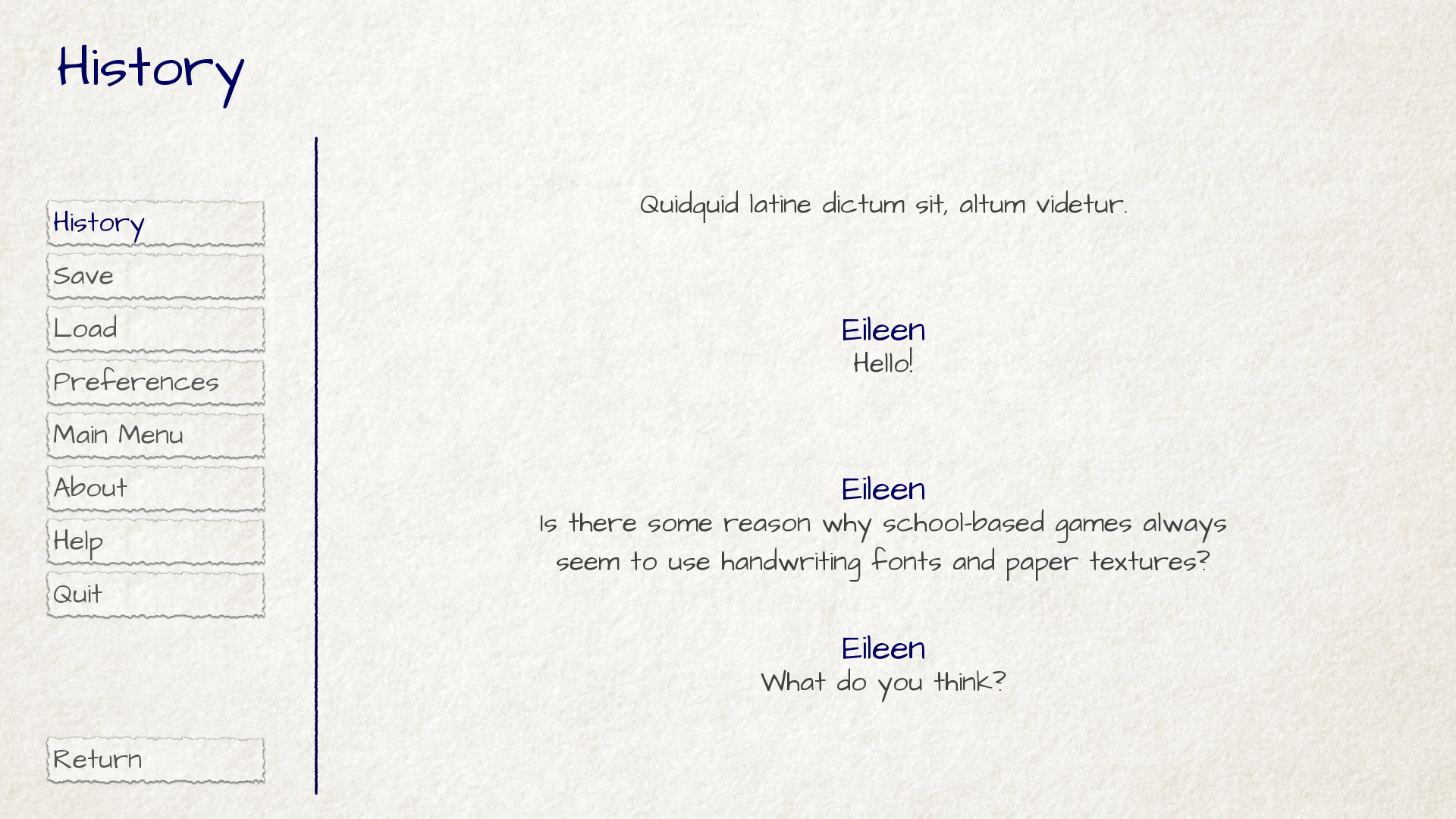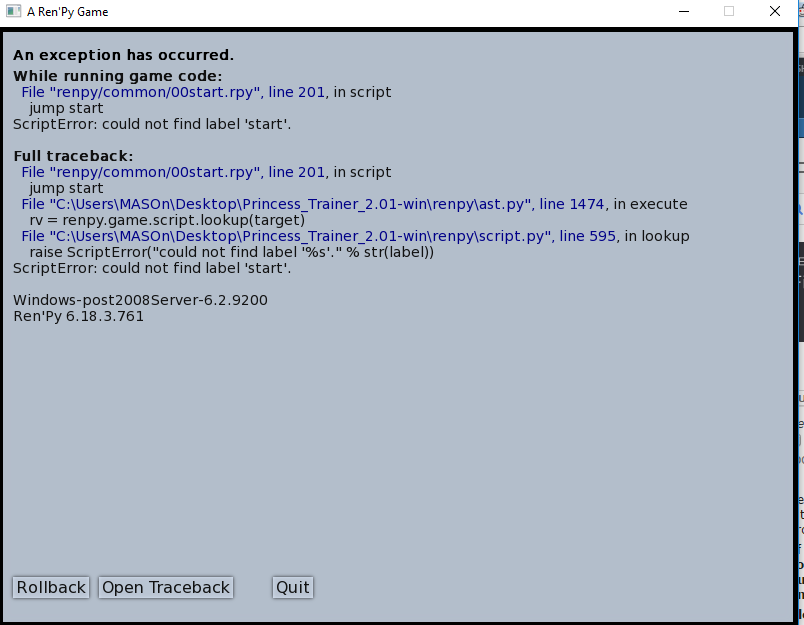Sakura Dungeon was made with the visual novel engine Ren'Py. It's makes it harder to hack the game with something like Cheat Engine, but it's based on Python, so the game scrips can be easily decompiled and modified. In case of Sakura Dungeon we don't have to decompile anything, the game got an developer console, that can be simple enabled. This game may not be suitable for people under 18 years of age. Engine: Ren'Py 6.17.6.512 Release 2.0. This release is not yet approved. Release Date: Jun 22, 2014 Platforms: Linux Engine: Ren'Py Ren'Py 6.17.6.512 Release 1.04. Contains various bugfixes. Game engine: Ren'Py Genre: (+18) SimLife / Brothel game Game Progression: Work in Progress Available version: (v0.7.1a) Download Available content in v0.6.0: Link (a small guide but OUTDATED!!!!) Most of my art and game graphics posted here: Modzso Games If you like my work, you can support me here: Patreon a few from the game characters: Bettie.
This kind of thing would probably be pretty useful in a game using the DSE (Dating Sim Engine offered in Frameworks. Here are two possible solutions for you. You can just copy and paste the code if you want and modify it to your purposes, but I encourage going through it to gain a deeper understanding of object-oriented programming. Problem with this game is that it uses renpy (python) and the values change. You could find money if you searched for a unique value like 127678. You would have to change every address to get the money you wanted, however, your next action would change the address again. The real way to cheat in this game is to enable to developer console.
You've reached a page on the Ren'Py wiki. Due to massive spam, the wiki hasn'tbeen updated in over 5 years, and much of the information here isvery out of date. We've kept it because some of it is of historic interest, but all theinformation relevant to modern versions of Ren'Py has been moved elsewhere.
Some places to look are:
Please do not create new links to this page.
So, you want to add a system that keeps track of money in the game so that the character can shop or earn coins, do you? This kind of thing would probably be pretty useful in a game using the DSE (Dating Sim Engine offered in Frameworks.
Here are two possible solutions for you.
You can just copy and paste the code if you want and modify it to your purposes, but I encourage going through it to gain a deeper understanding of object-oriented programming.
This is a beginner example and is probably the kind of thing you're going to want to use if you're only doing this once or twice. It also introduces some of the concepts that we're going to expand upon.
You can keep track of money... let's call it coins... with a variable. The $ (cash sign) means that we're using a python statement outside on an 'init python:' block.
We're going to initially set this value to 0. The 'label start:' tells Ren'Py where to begin at.
I'm leaving init blank for now.
Here's something new. We're declaring the variable 'items' as an empty set, usually defined by brackets such as '[' and ']'. Since it's empty, there's nothing-inbetween yet.

We've added a string that lets the player know what's happening. By using the += operator, we can add coins. We're adding 10 coins to zero.
%(coins)d is what we say if we want to put the number of coins into a string or dialogue of printed text. '%(coins)d' is a dynamic string that will insert the value of that variable, whether it's text or a number.
If my money was instead measured in 'pennies', then I would use '%(pennies)d'. The variable name goes inside the parentheses.
This kind of label lets Ren'Py know to offer the user a set of choices, which we will then define. Indentation is important. For menu labels, it is four spaces over.
By using the -= operator, you can subtract coins, just like before when we gave the player 10 coins by adding it to zero.
If you have a list named 'items', you can add things to the list by saying items.append('thing'). It's a python statement so we also use a $ sign.
Then we just put the rest of what we know into practice by making the rest of the menu options.
The question statement if 'object' in 'list' tells you whether or not the list contains that object. When we append 'chocolate' to 'items' then the brackets look like this to Ren'Py: ['chocolate']
If the player buys everything, it would look like this:
['chocolate', 'olives', 'spaghetti']
Here's an advanced solution using the long-term goal of classes of objects to reduce the amount of work needed over the entire project. I hope you're ready to put it all into practice.
You can actually read more about classes here: Classes in Python
This statement lets Ren'Py know to run this at the start ('init') and that it's python code ('python:') so none of these statements need a cash sign $ to prefix them.
It's a little different from the above method.
Here, we declare a class of objects, which is like a group.
We define some properties for it at initialization: name and cost.
'self' refers back to the original class ('Item') and the period is a break in the hierarchy. 'name' comes directly after that, so name is a property of 'Item'. The same thing is true of 'cost'.
We declare another class called 'Inventory'.
The 'Inventory' (self) is defined as having '10' money at initialization again. In other words, the variable container 'money' is set as equal to the number '10.'
Cheat Engine Renpy Games
This can be freely changed, of course. Just remember where it is, maybe leave a comment for yourself.
As before, we're declaring that the property 'money' of the 'self' (class Inventory) is contained within a global variable called 'money'.
This is an empty set called 'items' which can be filled, just like before—but now it's contained with the class called Inventory as an embedded property of that group.
We define another function: 'buy' with the property of 'item.'
If the money contained with the 'Inventory' is less than the 'cost' variable contained within the 'Item' class then we...
You may also notice the period between self and money. That tells Ren'Py the location of money in the hierarchy.
The >= syntax is identical to the += and -= we were using before, except that this time we're using it only to evaluate the container within the variable and not change it.
We subtract the amount of the cost away from the 'Inventory' money. In effect, the player has lost money.
We put the 'Item' into the 'Inventory'.
Just like in the beginner's code, we're adding the 'item' into the empty set.
The player bought the item.
The player didn't buy the item.
We're making another definition now, for the earning of money.
The variable in operation here is the 'amount' in question.
Again, 'self' still refers to class 'Inventory'. So what is earned is added from 'amount' into 'money.'
This is a definition that checks to see if the item is in the inventory or not.
This one is pretty self-explanatory and works like checking about adding an item into the 'items' container.
Was that a little confusing?
Let's see it in action.
This tells Ren'Py where to begin, just like last time.
You can declare a python block even from a 'start' label.
The variable 'inventory' is declared to be the same as the 'Inventory' class, which is followed by (). Again, no $ sign is necessary.
Spaghetti is declared to be of class 'Item.'
Notice that it's taking the arguments 'name' and 'cost' just like we declared before?
It costs 3 'money'.
We then apply that same kind of code to two other objects. Olives cost more than spaghetti and chocolate is obviously a luxury few can afford...
We state that 10 'money' is earned and sent to the inventory, after it goes to amount.
This is a hack to make the field a global so we can use it as a dynamic string below.
Like in Example 1, this string changes depending on the amount declared for the variable 'current_money'.
If you give the player 11 instead of 10 coins under the class Inventory, he can buy it.
The 'else' function just handles what happens if it's not possible to buy it. By the default option, the player can't afford it.
A 'jump' will go to the label and not return.
See below for these sections.
If the 'Item' 'chocolate' is contained within the 'Inventory' item set... then the statement below is printed:
Well, we only had 10 coins, huh?
Let's take a look at those shop labels.
We redefine some of the properties of the items into global variables.
By not including a colon, Ren'Py will display this dialogue at the same time as the menu.
This is just like we've done before, and here we're using a dynamic string for the cost of the spaghetti: that means you can change it in the future or maybe even lower it.
Then we jump down to the label game_continues which is covered further on below.
More of the same.
Always remember to give the player a neutral option when shopping. With a user interface, this would probably be a cancel imagebutton.
This is what happens when you can't afford an item.
The player's shopping trip ends here. You may notice the return of are global hack, this is because this code must be placed before all current_money variables to ensure they will work.
The last bit of code is mainly for testing reasons, to ensure that the money was removed from your inventory.
This is a short guide instructing the method to enable developer console. It allows you to apply cheat codes, ipatch and other stuffs.
First of all, run your Ren’Py game and press Shift+O (It is an O, not zero).
Not working? Alright, that means developer console is disabled for that game.
Enabling the Developer Console of Ren’py Games:

Step 1: Download This File
Or, Create a text document called options.rpy and paste below code there and Save.
init -1:
python hide:
config.developer = True
Second line needs 4 spaces before python hide:
Third line needs 8 spaces before config.developer = True*
If you dont know how to create a custom file, head over here: How to create a text document with custom extension in PC.
Step 2: Now you have to place the code in a folder called game inside your Ren’py game. The path should look like this, yourgamename/game/options.rpy
(if options.rpy already exists, simply rename your options.rpy to whatever name you prefer.)
Enabling the Console Commands on Ren’py Games:
Go to gamename/Renpy/Common/00console.rpy
Press Ctrl+F and enter config.console(Finding this term)
Set it’s variable to True
so it should look like,
config.console = True
Save the file.
Ren Py Console
Now the Shift+O should work.